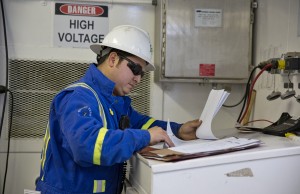Where do Pennsylvania’s gas industry jobs numbers come from?
-
Marie Cusick

Lindsay Lazarski/WHYY
Erik Melendez of Texas checks paperwork on a drilling site in Susquehanna County. “Every job here on the rig is tough,” he says. “It’s dangerous.”
It seems like a simple question: how many Pennsylvanians work in the Marcellus Shale industry?
The answer depends on how you decide to count. One of Governor Corbett’s recent campaign commercials touts the natural gas industry as “supporting over 200,000 jobs.”
Corbett’s Energy Executive, Patrick Henderson, puts the figure around “a quarter-million people at minimum” in the state’s oil and gas industry.
However, the most recent figures from the state Department of Labor and Industry paint a different picture.
The agency counts approximately 28,000 people currently working in these six oil and gas industries:
- Crude petroleum and natural gas extraction
- Natural gas liquid extraction
- Drilling oil and gas wells
- Support activities for oil and gas operations
- Oil and gas pipeline and related structures
- Pipeline transportation of natural gas

Sebastian Brinkenfeldt via flickr
The state’s Marcellus Shale jobs numbers capture everyone who works in 30 related industries (like trucking for example).
The department also counts everyone who works in 30 related (or ancillary) industries. These workers may not have anything to do with natural gas. For example, all truckers, engineers, environmental consultants, and road construction workers are counted.
The most recent ancillary figure is about 204,000 jobs.
Here’s the list of all the ancillary industries they count:
Fossil Fuel Electric Power Generation, Natural Gas Distribution, Water Supply & Irrigation Systems, Sewage Treatment Facilities, Water & Sewer Line & Related Structures Construction; Highway, Street, and Bridge Construction, Nonresidential Site Preparation Contractors; Petrochemical Manufacturing, Industrial Gas Manufacturing, Iron & Steel Mills & Ferroalloy Manufacturing; Iron & Steel Pipe & Tube Manufacturing from Purchased Steel; Mining Machinery & Equipment Manufacturing; Oil & Gas Field Machinery & Equipment Manufacturing; Construction and Mining (except Oil Well) Machinery and Equipment Merchant Wholesalers; Industrial Machinery and Equipment Merchant Wholesalers; Industrial Supplies Merchant Wholesalers; General Freight Trucking, Local; Specialized Freight Trucking, Local; Specialized Freight Trucking, Long-Distance; Lessors of Other Real Property; Construction, Mining & Forestry Machinery & Equipment Rental & Leasing; Engineering Services; Geophysical Surveying & Mapping Services; Testing Laboratories; Environmental Consulting Services; Remediation Services; Commercial & Industrial Machinery & Equipment Repair & Maintenance;Administration of Air and Water Resource and Solid Waste Management Programs; Administration of Conservation Programs; Regulation and Administration of Communications, Electric, Gas, and Other Utilities
StateImpact Pennsylvania recently sat down with James Martini, an economist at the state Department of Labor and Industry. He works on the agency’s quarterly “Marcellus Shale Fast Facts” and explains how they get their jobs numbers.
Note: this interview has been edited for length and clarity
Q: How big a deal is this industry to Pennsylvania’s economy in terms of jobs?
A: It’s a very big deal. Over the past several years we’ve seen employment in the core industries that are related to Marcellus Shale go from just over 10,000 to almost 30,000.
Q: Talk about how you formulate these numbers. I know this isn’t an exact science. It captures a lot of industries.
A: It starts with something called the North American Industry Classification System (NAICS) which is approximately 1,200 industries categorized and identified by the Bureau of Labor Statistics in Washington [D.C.].
We took all those industries and went through them one-by-one to determine which ones were primarily involved in the Marcellus Shale drilling extraction activities. We identify those industries as “core”.
We identified another 30 additional industries that are involved in “ancillary”—you can look at them as the supply chain to those core industries.
We then get data from the unemployment compensation tax records on 98 percent of the businesses in Pennsylvania. We classify those among the industries in NAICS, and we can then match those two up and get employment accounts for each of the industries.
Q: So in the most recent dataset there are 28,155 jobs in core industries and 203,814 in related [ancillary] jobs.
A: Yes, that’s the most quarter of data available [First quarter of 2013]. The data is not seasonally adjusted which is why you’ll see when the documents come out—for example we compare quarter one of 2013 to quarter one of 2009 to take out those seasonal factors .
Q: I know you have to be careful with your language about what this all means. But I hear the Corbett administration say there are approximately a quarter-million people benefiting from this industry with jobs. Is that correct?
A: I think in some respects it can be a conservative estimate. I think in other respects you’re making an apples to oranges comparison.
A lot of the numbers cited with the quarter-million number are derived from economic impact models that measure direct, indirect, and induced employment. What we’re doing here in something slightly different. [Note: For example, induced would be a hotel or restaurant seeing increased business].
We’re getting actual data and employment counts and we’re able to classify those into specific industries. So while it’s true that not every engineering services job in the state is directly related to Marcellus Shale—every person working in Marcellus Shale in engineering services is going to be found in that industry.
Our numbers do not capture the induced impacts, which is something you find in the economic models. All the additional spending that comes from the employment and the wages earned in both the direct and indirect industries are going to have spillover effects in the economy. You’re going to see increased employment in hotels and restaurants, local hospitals. It’s going to impact the local housing market.
Q: Is there a way you can tell who is from Texas and who is a Pennsylvanian?
A: We have done some research into that. The most recent analysis we ran was the second quarter of [2013]. I believe it’s 60 percent [Pennsylvanians].That only counts new hires in the core industries.
New hires certainly don’t represent every single individual working in the industry. One of the issues was there wasn’t the legacy of horizontal well drilling in the state. When the boom started here, you saw local training providers and local community colleges start to build up programs.
As more people got trained over time, it increased the local skillset to be able to take those jobs. Being on a rig, you know, safety is a paramount concern. Putting all new people onto a rig site is inherently dangerous. [Drilling companies] had to make sure the local population taking those jobs had the requisite training.
Q: You really saw your jobs data spike in 2010, correct?
A: Yeah, you saw slow and steady employment growth in the few years preceding it. But things really started to take off at the end of 2009, at the beginning of 2010. You saw a large growth in employment among the mining industries.
Q: But it looks like it’s dropped since then.
A: They have. [The numbers] leveled or stopped growing at the rate they were. Part of that is a reflection of the commodity price of natural gas. It’s not as economical to drill wells right now.
From the individuals I’ve talked to in the industry, they seem pretty confident that once the price rebounds you’ll see the growth pick back up. But we have seen the employment level off in the last six to 12 months.
Q: Why is Pennsylvania’s overall unemployment rate higher than the national average if the Marcellus Shale industry has been so transformative?
A: The Marcellus Shale is only one portion of the state’s economy—and we have seen that impact. Especially when the shale activity first picked up, you saw lower unemployment rates in the areas where drilling was taking place.
Q: Is it fair to say we just have such a large economy that no matter what we’re talking about one industry can’t change everything?
A: I think that’s a fair point.
















